Introduction
Feed the Future is a U.S. Government initiative that explicitly aims to improve nutrition through agriculture-led activities that also strive to reduce rural poverty in 19 focus countries.

The initiative strives to both improve nutrition where it works and to contribute to the evidence base demonstrating how agriculture affects diet and nutrition for rural families. Agriculture is the main livelihood and employer of most of the nutritionally vulnerable households in the world (World Bank 2007; World Bank 2013). For the rural households targeted under the Feed the Future initiative, agriculture is the primary way people make a living. Agriculture, and in particular, food systems, provide food for all human beings and thus have a foundational role in nutrition. The potential for agriculture development and food systems to improve nutrition is well recognized—most importantly through providing access to diverse, nutritious diets. In general, agricultural growth is more pro-poor and is associated with greater reductions in stunting than nonagricultural growth (World Bank 2007; Webb and Block 2012). Yet the full potential of agriculture to improve the nutrition of vulnerable individuals within farming households, as well as of the general population, has yet to be realized (Ruel and Alderman 2013; Webb 2013). Recent systematic reviews have pointed to a need for more and better designed research to understand how agriculture interventions can harness the potential to improve nutrition more fully (Ruel and Alderman 2013; Hawkes et. al 2012; Herforth et al. 2012; Masset et al. 2012).
The pathways and principles explored in this brief provide a summary of the current state of knowledge of ways to use agriculture to improve nutrition. Broadly accepted among development partners, these concepts are based on the best evidence available from the literature on food security, health, and nutrition and are supported by the experiences of field practitioners, including those implementing activities under Feed the Future. These concepts can aid in the design and implementation of nutrition-sensitive agriculture programs. This brief does not assume that all agricultural development activities are “nutrition sensitive.”
The pathways and principles explored in this brief provide a summary of the current state of knowledge of ways to use agriculture to improve nutrition.
However, the pathways and principles may assist Feed the Future practitioners to systematically consider both opportunities and threats to nutrition across the range of current agricultural interventions. This is particularly relevant given that Feed the Future’s results framework pursues high-level outcomes for both agriculture and nutrition.
Causes of Malnutrition and the Need for Multisectoral Approaches
Nutritional status is determined by three broad factors:
Food: access to sufficient, safe, nutritious food to support a healthy, active life.
Health: including (a) the health environment in terms of pathogens and environmental contaminants, water, and sanitation; and (b) access to health services.
Care: child feeding and care practices and care of women.
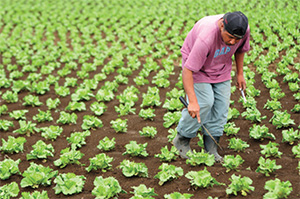
© Maria Fleischmann/World Bank
The United Nations Children’s Fund’s (UNICEF’s) framework for malnutrition (Annex 2) lays out this understanding of the determinants of malnutrition, including its immediate, underlying, and basic causes (UNICEF 1990). Nutrient intake and health status at the level of the individual are the immediate determinants of nutritional status. Underlying these are the food, health, and care determinants described above; these are what one can affect through agriculture. Finally, at a basic level, political, economic, and institutional determinants underpin all of these factors. Given these multiple causes, it is clear that no single sector can address malnutrition alone; several sectors have a role to play.
There are two groups in the population that are especially vulnerable to undernutrition: pregnant/lactating women and children, especially those under two years old. Undernutrition during a child’s critical period—from mother’s pregnancy to age two years—can cause irreversible physical and cognitive deficits (Bhutta 2013). For this reason, mothers and young children are often the target groups for nutrition-specific interventions. In food security programs, improving the nutrition of girls and women is an important consideration not only for their own health, but also because the health and nutritional status of pregnant and lactating mothers is critical to the nutrition of children under two. Improving women’s nutrition is critical to breaking the intergenerational cycle of undernutrition and is essential to sustained economic growth, given the negative impact that chronic undernutrition has on productivity, educational attainment, and income-earning potential (Bhutta 2013).
Nutrition may be protected if agricultural livelihoods guarantee a reliable and sustainable income and if that income is used to purchase diverse, nutritious food as well as to obtain health care, education, shelter, fuel, and other basic necessities required for a healthy, productive life. Agriculture has a unique role in ensuring access to and availability of diverse, nutritious food. At the same time, agricultural development projects should avoid doing unintentional harm to public health (e.g., by protecting potable water and maintaining an environment free of contaminants) and should support the care of children and families (e.g., by reducing demands on women’s use of time and energy). Addressing food availability and access is critically important but may not have a measurable impact on nutritional status, especially if other factors limit child growth, such as poor sanitation, inadequate care practices, or lack of access to quality health services. The strong evidence base that links the use of maternal, infant, and young child feeding and care practices to reductions in chronic malnutrition— across all socioeconomic strata—supports the utility of integrating nutrition social and behavior change (SBC) into agriculture development activities.
The strong evidence base that links the use of maternal, infant, and young child feeding and care practices to reductions in chronic malnutrition supports the utility of integrating nutrition social and behavior change (SBC) into agriculture development activities.
How Agriculture and Food Systems Affect Nutrition
Agricultural livelihoods affect nutrition of individual household members through multiple pathways and interactions. The framework depicted below helps us to understand how various agriculture investments or activities could improve access to food and health care; how they impact and are affected by the enabling environment; and how they ultimately affect the nutrition of individual women and children.
The pathways are not always linear, and there are many interactions among them. In general, they can be divided into three main routes at the household level: 1) food production, which can affect the food available for household consumption as well the price of diverse foods; 2) agricultural income for expenditure on food and non-food items; and 3) women’s empowerment, which affects income, caring capacity and practices, and female energy expenditure. Acting on all of these routes is the enabling environment for nutrition, including several key components: the natural resources environment; the food market environment; the health, water, and sanitation environment; nutrition/ health knowledge and norms; and other factors, such as policy and governance. These components may affect nutrition of consumers or communities, not only farmer households. Child nutrition outcomes ultimately feed back into national economic growth and household assets and livelihoods, including those that contribute to both agricultural and nonagricultural sources of income.
Figure. Conceptual Pathways between Agriculture and Nutrition
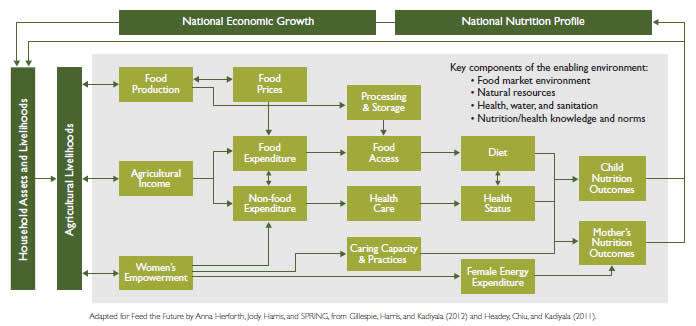
Source: Herforth and Harris, 2014
Pathways between Agriculture and Nutrition
This brief addresses how agricultural livelihoods and food systems may more effectively contribute to household food security and nutritional status. The following section describes how the primary pathways in the figure above enable agriculture to contribute to reductions in undernutrition.

© Curt Carnemark/World Bank
Food Production
Household food production can be critically important to the diets and nutrition of individuals in smallholder farmer households. In general, however, it is not the primary objective of an agricultural livelihood to produce all the food a family needs; most poor rural families are net purchasers of food. However, for those with access to arable land, it is a combination of food produced for consumption, income, and local food availability and prices that determines the family’s food security. Food production can affect the type, quantity, and seasonality of food available in the household for consumption. At the same time, production may also influence the availability and prices of diverse food in local markets.
The decisions farmers make about crop and livestock production are affected by many factors, including potential market prices, relative costs and risks associated with each product, the assets and endowments of land the household possesses, and family needs and preferences. If preferred foods or varieties are not consistently available, affordable, or conveniently accessible in markets, raising or growing them on the farm may be the most efficient way to obtain them. Substituting a more nutritious variety of a crop already grown for consumption (e.g., substituting yellow, vitamin A maize for white maize or orange cassava for regular cassava) may be an easy way to improve nutrition as part of the overall set of livelihood decisions. Nutrition knowledge and SBC are therefore essential to informing the range of decisions that farmers make about what they grow to consume, what they grow to sell, and what they decide to purchase with their income.
Processing and storage can affect the shelf life, safety, and nutrient content of foods in positive or negative ways for nutrition and health. These actions may also have a positive or negative effect on income-earning potential (through value addition) based on the food market environment. For example, storage conditions can affect the level of mycotoxin contamination (Yohe and Williams 2005) and drying meats, fruits, vegetables, or fish or producing cheese can reduce losses and make nutritious foods available out of season for both home consumption and for sale in local markets (Rahman 2007).
Agricultural Income
Keys to reducing poverty in rural areas are establishing and maintaining successful small farming businesses that ensure livelihoods. Therefore, one of the primary aims of most Feed the Future activities is to increase household income through agriculture. Improved year-round income and cash flow can then be used for immediate or future household needs, including food and non-food purchases to support a healthy diet and life.
The agriculture income pathway assumes that nutritious, diverse foods are available and affordable in local markets. Appropriate inputs to grow these diverse foods must also be available so local production can meet demand. Additionally, market and transportation systems must enable year-round and/or seasonal supplies based on consumer preferences and purchasing power. Local supply and demand may also be influenced not only by market prices but also by SBC, nutrition knowledge, and social marketing, which may help drive consumer preferences.
At the same time, household investments in health, including potable water sources and toilets, preventive care, and other basic necessities, are crucial to supporting good nutrition, especially for women and young children. All rural farm households must balance their spending decisions between farm production and marketing investments and the immediate purchases of food, health, and care necessities. The effect of income on nutrition is not direct or easily predictable; it is always modified by what is available, affordable, and convenient to purchase; who decides what is purchased; and the myriad factors that drive that decision.
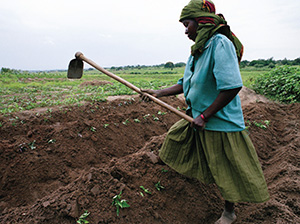
© Scott Wallace/World Bank
Women’s Empowerment
Women’s empowerment incorporates multiple aspects, including the decision-making power related to income, time, labor, assets, and knowledge or preferences of female community members.
Increasing the agricultural income that women can control strengthens the income pathway to nutrition. Women’s income enables expenditures on food and health care, affecting diet and health status. Research shows that in many places around the world, income controlled by women is more frequently used on food and health care for the family, particularly for children (UNICEF 2011; Smith et al. 2003). Often, the best way for women to influence how household income is spent is by earning their own income. For women in rural areas, an agriculture-related livelihood is the most common way a family makes a living. Women’s decision-making also affects what is produced on the farm, and women’s control of income and assets can affect productivity based on their spending decisions and on the social networks and cultural norms that influence those decisions (Food and Agriculture Organization of the United Nations [FAO] 2011). Training female and male farmers in farm management and business skills can optimize the income earned with the available time, labor, assets, and capital.
…a vital step in improving nutrition in a household with an agricultural livelihood requires that farming business decisions give attention to how women are involved…
Agricultural development interventions can strongly affect women’s use of time as well as their labor burden. Women are typically responsible for a wide range of household and agricultural tasks, including child and infant care and feeding and their own self-care. Activities that influence the amount of time or labor women spend on agriculture- related tasks can affect their own health and energy expenditure, and in turn their capacity to feed and care for infants, young children, and themselves. For this reason, a vital step in improving nutrition in a household with an agricultural livelihood requires that farming business decisions give attention to how women are involved in agriculture activities. For example, if agriculture development activities strive to promote the production of various nutritious foods with high market value to help increase women’s income, they must be designed and monitored to also ensure they are not contributing to women’s time and labor burdens.
The Enabling Environment
The pathways between agriculture and nutrition are influenced by several key contributors to the enabling environment, which are factors at the community, regional, or national level affecting the household-level pathways. The enabling environment is shown as the shaded box behind the pathways in the figure above. Its key components include the food market environment; the natural resources environment; the health, water, and sanitation environment; and knowledge and norms. It should be noted that agricultural interventions and policies can affect these components. The interaction between the various components of the enabling environment and the agriculture-to-nutrition pathways are described in the following section.

© Simone D. McCourtie/World Bank
Food Market Environment
Feed the Future promotes inclusive agriculture sector growth that expands markets and trade for smallholder farmers. The food market environment affects the kinds of foods that are available and likely to be purchased, as well as those that are likely to be produced by farm households as a response to price signals and market incentives. Farm households determine what gets sold in markets and what is consumed at home largely as a response to the food market environment.
Both government policies and the actions of the private sector impact the availability and affordability of food in the market. For example, open international trade policies may increase the availability in local markets of imported food and beverages that can significantly affect local diets. By the same token, favorable tax policies may increase household access to nutrient-dense food products. Public and private investments in food value chains meanwhile determine the processing, storage, and marketing of food, affecting the quantity and quality (including safety) of food in the market.
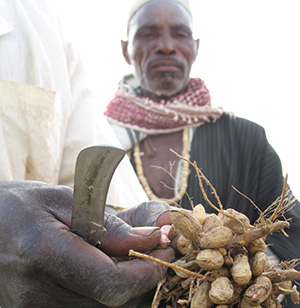
© Aaron Buchsbaum/JSI
Finally, agriculture and food systems contribute greatly to the food market environment in how nutrition messages are conveyed to consumers. Labeling and social marketing, for example, are tools that have been used by the food marketing industry and other value chain actors to influence food purchase decisions and consumption habits. This type of marketing may influence what people eat more extensively than nutrition education. Purchase decisions are affected not only by the relative price of different foods, but also factors such as convenience of purchase and preparation, available information about foods, and related perceptions of quality and safety. The last two factors in particular are influenced by marketing efforts of the private and public sectors. The food environment therefore interacts with household decision-making and food purchases in many ways and has a significant influence on household and individual nutrition.
Natural Resources Environment
All pathways between agriculture and nutrition are affected by natural resources: water, soil, climate, and biodiversity. Natural resource endowment affects agricultural production potential and, therefore, management strategies for income generation and food availability. Appropriate management of often scarce natural resources, such as sustainable harvesting, use and drainage of water, soil fertility management, and managing access to productive land, is critical to a successful farming business. Rainfall patterns directly impact production cycles of farms without access to irrigation; and water availability, often a cause of human conflict, determines the type of viable farming systems. Access to potable water is essential for human health and nutrition—for sustenance, food preparation, and hygiene and sanitation. Irrigation for agriculture can impact human health, especially in areas of intensive cultivation that use chemical inputs.
… successful interventions along any of the pathways will require purposeful planning toward nutritional goals while mitigating ever-changing natural resource constraints.
Soil quality directly affects the quality and yield of crops, and maintaining its fertility over time is a primary consideration in farming as a source of food and income. Additionally, access to productive lands is often contested due to cultural norms and/or political influence, often to the detriment of women’s access to land resources, especially in the context of growing populations. Therefore, the appropriate management of scarce natural resources has direct consequences for the livelihoods of food insecure and nutritionally vulnerable families. With changing climate patterns, the predictability of farm production cycles is also affected. Early or late onset of rains, floods, droughts, shortened crops seasons, and premature harvests are causing yield declines, which lead to decreased food availability and/or income for farming households. These challenges require farmers to continually adapt their agricultural livelihood strategies to maintain the viability of crops and livestock. Therefore, successful interventions along any of the pathways will require purposeful planning toward nutritional goals while mitigating ever-changing natural resource constraints.
Programming Principles
- Incorporate explicit nutrition objectives and
indicators into design.- Assess the local context.
- Target the vulnerable and improve equity.
- Collaborate and coordinate with other sectors.
- Maintain or improve the natural resource base, particularly water resources.
- Empower women.
- Facilitate production diversification, and increase production of nutrient-dense crops and livestock.
- Improve processing, storage, and preservation of nutritious food.
- Expand market access for vulnerable groups, and expand markets for nutritious foods.
- Incorporate nutrition promotion and education that builds on local knowledge.
Health, Water, and Sanitation Environment
Nutritional status is strongly influenced by the health, water, and sanitation environment and access to health services. Agricultural production interacts with the health, water, and sanitation environment. For example, some agricultural practices may contaminate water available for household use (e.g., with agrochemicals or microbes from livestock); water management may contribute to waterborne diseases (e.g., when standing water creates reservoirs that harbor disease vectors); and exposure to zoonotic disease or agrochemicals poses risks to human health, particularly during pregnancy. Infants and young children may be at risk of illness when livestock or agricultural production diminishes household sanitary conditions. With compromised systems, children are unable to properly absorb the nutrients they are consuming, thus negating any potential positive nutrition outcomes from increases in agriculture production or income. A key component of nutrition-sensitive agriculture therefore includes consideration of the activities’ potential effects on the health, water, and sanitation environment.
Illness and poor health, whether resulting from agricultural practices or not, may affect household agricultural productivity as a whole. For example, in households or communities experiencing chronic or seasonal illness, food production and income generation are compromised by a lack of labor.
Nutrition/Health Knowledge and Norms
The knowledge held by key family and community members has a major bearing on the decisions made within households related to agriculture and nutrition. For example, Feed the Future activities that promote knowledge of nutrition and health may affect decisions around food production, purchase, and consumption to enhance positive outcomes for both the agriculture and nutrition sectors while avoiding negative impacts. An example of this can be seen in activities that promote farm management and business planning skills, as these have proven to be essential for successful farmers. Business planning should take household expense and cash flow needs, both planned and unplanned, into account. Including costs for the purchase of a healthy diet, antenatal care, or unforeseen illness as a part of a smallholder’s business plan is not only beneficial to the family’s livelihood but also to its nutrition, health, and well-being.
Policy Principles
- Increase incentives (and decrease disincentives) for availability, access, and consumption of diverse, nutritious, and safe foods.
- Monitor dietary consumption and access to safe, diverse, and nutritious foods.
- Include measures that protect and empower the poor and women.
- Develop capacity to improve nutrition through the food and agriculture sectors.
- Support multisectoral strategies to improve nutrition.
Decisions that result in improved market access and income for farm households require knowledge and skills in production, storage, processing, selling, and marketing, to name a few of the many areas in which farmers are expected to be “experts.” The knowledge and use of key agricultural practices and skills can also easily include information that builds awareness and protects against harm to health and nutrition. For example, nutrition-sensitive livestock-raising practices may change how animals are kept in relation or proximity to the home, or nutrition-sensitive irrigation practices may affect how water is managed for agriculture to avoid household consumption of contaminated water. SBC activities promoting nutritious diets and healthy practices— whether provided within an extension system or as part of a collaboration with other sectors—can further enhance the impact of agriculture activities on nutrition.
Key Principles for Improving Nutrition through Agriculture
The current global consensus of Key Recommendations for Improving Nutrition through Agriculture reflects the agriculture-nutrition pathways identified in this brief. The United States Agency for International Development contributed to the identification and sharpening of these recommendations within a broad consultation process that included discussions and country presentations at regional Agriculture and Nutrition Global Learning and Evidence Exchange workshops.
This collaborative process yielded a consensus list of 10 key principles for programming and five principles for policy (above right and in full in Annex 3). The 10 programming principles include broadly supported priorities for nutrition-sensitive agriculture that seem to be common among activities that have shown a positive impact on nutrition.

© Alyssa Klein/JSI
Application of the Pathways and Principles
The pathways framework is envisioned as a conceptual tool for activity planners to explore ways in which interventions may impact human nutrition. The framework outlines key theoretical steps needed to reach outcomes on dietary consumption or women’s income or to have an impact on nutritional status. While these pathways are not linear, and the interactions in some contexts are quite complex, the framework can be a useful tool in activity design. It is also useful for making decisions about how best to measure the success of an approach on its intended outcomes.
The key principles can be used as a broad checklist in the design of nutrition-sensitive activities. The contribution of agriculture to nutrition goals will be different depending on the context and the type of activities undertaken. The first two principles, however—having a nutrition objective and context assessment—will be critical in all cases. Assessing the local context is essential to understanding constraints and opportunities in agriculture and nutrition from all points of view, including the viewpoint of beneficiaries. For example, context assessment can:
- Identify causes of undernutrition and which pathway( s) are primarily implicated.
- Aid in defining target groups (e.g., the poorest of the poor or vulnerable but viable farmers) for activities.
- Help identify activities of government and nongovernmental organizations in the same areas and other donors’ investments to identify synergies and avoid duplicating efforts.
The pathways can also inform the choice of activity-specific indicators for measuring positive impact on nutrition. Appropriate indicators will vary according to which pathways are relevant to the activity design. However, indicators of food access and diet quality and diversity are key to linking agriculture investment to nutrition outcomes for vulnerable groups.
Conclusion
Reductions in undernutrition can be achieved through simultaneous cross-sectoral attention to food, care, and health determinants of nutrition. Interventions in the food system can support farm systems and agricultural livelihoods while also improving diets. This is especially true if the interventions do no harm to health or care practices and support integrated and multisectoral programming. The pathways and principles outlined in this brief can guide agriculture activity planning to improve nutrition.
Annex I: Aspects of Nutrition and Agriculture: Terms to Know
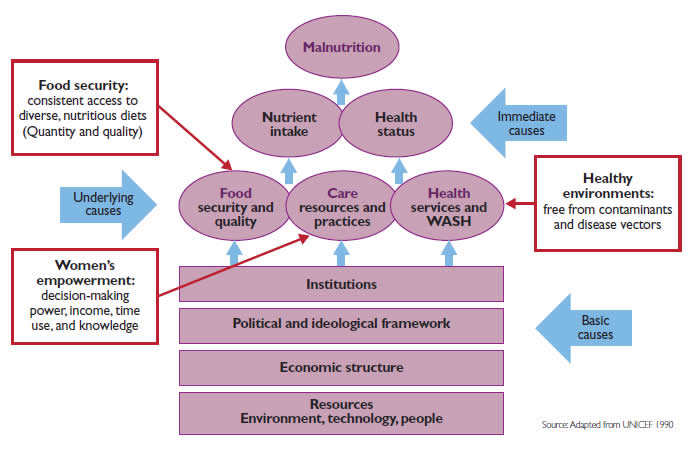
Nutrition Terms
| Malnutrition: | A catch-all term, including undernutrition, overweight, and micronutrient malnutrition. |
| Micronutrient malnutrition: | Deficiency of vitamins and minerals (for example, iron and vitamin A); can occur alongside undernutrition or obesity. |
| Nutrition-sensitive: | Interventions or programs that address the underlying determinants of fetal and child nutrition and development— food security; adequate caregiving resources at the maternal, household, and community levels; and access to health services and a safe and hygienic environment—and incorporate specific nutrition goals. Nutrition-sensitive programs can serve as delivery platforms for nutrition-specific interventions, potentially increasing their scale, coverage, and effectiveness. Examples: agriculture and food security; early child development; women’s empowerment; social safety nets; and water, sanitation, and hygiene. |
| Nutrition-specific: | Interventions or programs that address the immediate determinants of fetal and child nutrition and development— adequate food and nutrient intake, feeding, caregiving and parenting practices, and low burden of infectious diseases. Examples: adolescent and maternal health and nutrition; maternal and child dietary or micronutrient supplementation or fortification; promotion of optimum breastfeeding; complementary feeding; treatment of severe malnutrition; and nutrition in emergencies. |
| Nutritious, nutrient dense: | Foods with a high micronutrient and/or protein content per calorie. |
| Overweight and obesity: | Weight that is above normal for an individual’s height, measured as weight-for-height for children 6–59 months and as body mass index (BMI) for older children, adolescents, and adults. Can lead to chronic disease, disability, and birth outcome risks. |
| Social and behavior change: | Social and behavior change (SBC) is a behavior-centered approach to facilitating individuals, households, groups, and communities to adopt and sustain improved, evidence-based practices. The approach draws upon social science and behavior change theories to design policies and interventions that address behavior and the environment within which behavior change occurs. |
| Undernutrition: | Inadequate intake and/or absorption of calories and essential nutrients, manifested as: Acute undernutrition: The result of recent and acute deprivation and measured as wasting (low weight for a child’s height), mid-upper arm circumference, and clinical signs of bipedal edema. Chronic undernutrition: Occurs over time and is measured as stunting (low height for a child’s age). Underweight: Low weight for a child’s age or low BMI in adults. Can result from chronic and/or acute undernutrition. |
Agriculture Terms
| Agricultural income: | Income derived from agricultural livelihoods, that is, livelihoods involving the production, processing, marketing, distribution, utilization, and trade of food, feed, and fiber. |
| Agricultural livelihoods: | Means of support or subsistence derived from agriculture, that is, the production; processing; marketing; distribution; utilization; and trade of food, feed, and fiber. |
| Agriculture: | The science and practice of activities related to production; processing; marketing; distribution; utilization; and trade of food, feed, and fiber. This definition, cited in the 2004 USAID Agriculture Strategy and derived from the 2000 Famine Prevention and Freedom from Hunger Improvement Act, also includes family and consumer sciences, nutrition, food science and engineering, agricultural economics and other social sciences, forestry, wildlife, fisheries, aquaculture, floriculture, veterinary medicine, and other environmental and natural resource sciences. It also encompasses efforts to develop agricultural policies and institutions, such as research and extension services, that support agriculture and improve productivity to catalyze rural economic growth. |
| Agriculture-Nutrition: | Concepts, ideas, strategies, and activities that aim to enhance the nutrition outcomes and eventual nutrition impact of food systems. |
| Farming system: | The dominant pattern of farm activities and household agricultural livelihoods, taking into account the available natural resource base, farm size, tenure, organization, and main technologies used, which determine the intensity of production and integration of crops, livestock, and other activities. |
| Food security: | When all people at all times have physical and economic access to sufficient, safe, and nutritious food to meet their dietary needs and food preferences for a healthy and active life. |
| Food systems: | Food systems encompass the entire range of activities involved in the production, processing, marketing, consumption, and disposal of goods that originate from agriculture, forestry, or fisheries, including the inputs needed and the outputs generated at each of these steps. Food systems also involve the people and institutions that initiate or inhibit change in the system as well as the sociopolitical, economic, and technological environment in which these activities take place. |
| Household income: | All income derived by household members from all sources. |
| Market systems: | Complex webs of interconnected relationships among market actors and within and across industries, firms, and households; a system operating within policy environments, cultural norms, social and economic incentives, levels of loyalty and trust; and interfacing with other systems, such as education, health, and nutrition. |
| Value chain: | The full range of actors, activities, and services required to bring a product or service from its conception to sale in its final markets, including input suppliers, producers, processors, and buyers, as well as support services and enabling environments that form a dynamic market system. |
,
Annex II: UNICEF Framework for Malnutrition
,
Annex III: Key Policy and Programming Principles for Improving Nutrition through Agriculture
Programming Principles
Agricultural programs and investments can strengthen impact on nutrition if they:
- Incorporate explicit nutrition objectives and indicators into their design and track and mitigate potential harms while seeking synergies with economic, social, and environmental objectives.
- Assess the context at the local level to design appropriate activities to address the types and causes of malnutrition.
- Target the vulnerable and improve equity through participation, access to resources, and decent employment.
- Collaborate and coordinate with other sectors (health, environment, social protection, labor, water and sanitation, education, and energy) and programs through joint strategies with common goals to address concurrently the multiple underlying causes of malnutrition.
- Maintain or improve the natural resource base (water, soil, air, climate, and biodiversity), which is critical to the livelihoods and resilience of vulnerable farmers and to sustainable food and nutrition security for all. Manage water resources in particular to reduce vector-borne illness and to ensure sustainable, safe household water sources.
- Empower women by ensuring access to productive resources, income opportunities, extension services and information, credit, and labor- and time-saving technologies (including energy and water services) and by supporting their voice in household and farming decisions. Equitable opportunities to earn and learn should be compatible with safe pregnancy and young child feeding.
- Facilitate production diversification, and increase production of nutrient-dense crops and small-scale livestock (for example, horticultural products, legumes, livestock and fish at a small scale, underutilized crops, and biofortified crops). Diversified production systems are important to vulnerable producers to enable resilience to climate and price shocks, more diverse food consumption, reduction of seasonal food and income fluctuations, and greater and more gender-equitable income generation.
- Improve processing, storage, and preservation to retain nutritional value, shelf life, and food safety; reduce seasonality of food insecurity and post-harvest losses; and make healthy foods convenient to prepare.
- Expand markets and market access for vulnerable groups, particularly for marketing nutritious foods or products vulnerable groups have a comparative advantage in producing. This can include innovative promotion (such as marketing based on nutrient content), value addition, access to price information, and farmer associations.
- Incorporate nutrition promotion and education around food and sustainable food systems that builds on existing local knowledge, attitudes, and practices. Nutrition knowledge can enhance the impact of production and income in rural households, which is especially important for women and young children, and can increase demand for nutritious foods in the general population.
Policy Principles
Food and agriculture policies can have a better impact on nutrition if they:
- Increase incentives (and decrease disincentives) for availability, access, and consumption of diverse, nutritious, and safe foods through environmentally sustainable production, trade, and distribution. Focus on horticulture, legumes, and small-scale livestock and fish—foods that are relatively unavailable and expensive but nutrient rich and vastly underutilized as sources of both food and income.
- Monitor dietary consumption and access to safe, diverse, and nutritious foods. The data could include food prices of diverse foods and dietary consumption indicators for vulnerable groups.
- Include measures that protect and empower the poor and women. Safety nets that allow people to access nutritious food during shocks or seasonal times when income is low; land tenure rights; equitable access to productive resources; and market access, including information and infrastructure, for vulnerable producers. Recognizing that a majority of the poor are women, ensure equitable access to all of the above for women.
- Develop capacity in human resources and institutions to improve nutrition through the food and agriculture sectors, supported with adequate financing.
- Support multi-sectoral strategies to improve nutrition within national, regional, and local government structures.
These recommendations have been formulated following an extensive review of available guidance on agriculture programming for nutrition conducted by FAO, and through consultation with a broad range of partners (CSOs, NGOs, government staff, donors, UN agencies), in particular through the Agriculture-Nutrition Community of Practice. These recommendations are available from the Agriculture-Nutrition Community of Practice
.
This series of briefs illustrates how a set of pathways and principles may assist Feed the Future stakeholders to strengthen agriculture and nutrition linkages across and within country portfolios. Short vignettes from agriculture activities highlight how the pathways and principles can be applied in diverse contexts. The conceptual frameworks of the pathways and principles for improving nutrition through agriculture are described in the first brief. Each subsequent brief explores a different route between agriculture and nutrition: food production, income generation, and women’s empowerment.
Footnotes
1 See Annex 1 for a glossary of terms related to agriculture, food systems, and nutrition that are used in this brief.
2 The complete original document is available from the Ag2Nut Community of Practice
.
3 This process included feedback from the 800-member Agriculture-Nutrition (Ag- 2Nut) Community of Practice, the FAO, the United Nations Standing Committee on Nutrition, and the Comprehensive Africa Agriculture Development Programme workshops to mainstream nutrition.
4 Adapted from FAO. “Analysis of Farming Systems.”
Farming Systems and Poverty. (Accessed December 31, 2013).
5 Food and Agriculture Organization of the United Nations (FAO). 1996. “Rome Declaration on World Food Security,”
November 13. World Food Summit. (Accessed December 31, 2013).
6 ———. 2013. The State of Food and Agriculture: Food Systems for Better Nutrition.
Rome: FAO.
7 Adapted from Downing, Jeanne. 2013. “Market Systems Development- USAID-DFID-SDC Collaboration.”
Promoting Inclusive Markets and Financial Systems, October 31. (Accessed December 31, 2013).
8 Context assessment can include potential food resources, agro-ecology, seasonality of production and income, access to productive resources, such as land, market opportunities and infrastructure, gender dynamics and roles, opportunities for collaboration with other sectors or programs, and local priorities.
9 Malnutrition includes chronic or acute undernutrition, vitamin and mineral deficiencies, obesity, and chronic disease.
10 Vulnerable groups include smallholders, women, youth, the landless, urban dwellers, and the unemployed.
References
Bhutta, Zulfiqar A. 2013. “Early Nutrition and Adult Outcomes: Pieces of the Puzzle.” The Lancet 382:486–487. doi: 10.1016/S0140-6736(13)60716-3.
Food and Agriculture Organization of the United Nations (FAO). 2011. The State of Food and Agriculture 2010–2011: Women in Agriculture: Closing the Gender Gap for Development
. Rome: FAO.
———. 2013. Synthesis of Guiding Principles on Agriculture Programming for Nutrition
. Rome: FAO.
Gillespie, Stuart, Jody Harris, and Suneetha Kadiyala. 2012. The Agriculture-Nutrition Disconnect in India: What Do We Know?
IFPRI Discussion Paper 01187. Washington, DC: International Food Policy Research Institute (IFPRI).
Hawkes, C., R. Turner, and J. Waage. 2012. Current and Planned Research on Agriculture for Improved Nutrition: A Mapping and a Gap Analysis
. Report for the Department for International Development (DFID). London: Leverhulme Centre for Integrative Research on Agriculture and Health; Aberdeen, United Kingdom: University of Aberdeen, Centre for Sustainable International Development.
Headey, Derek, Alice Chiu, and Suneetha Kadiyala. 2011. Agriculture’s Role in the Indian Enigma: Help or Hindrance to the Undernutrition Crisis?
IFPRI Discussion Paper 01085. Washington, DC: International Food Policy Research Institute (IFPRI).
Herforth, Anna, Andrew Jones, and Per Pinstrup-Andersen. 2012. Prioritizing Nutrition in Agriculture and Rural Development: Guiding Principles for Operational Investments
. Health, Nutrition, and Population (HNP) Discussion Paper. Washington, DC: The World Bank.
Masset, E., L. Haddad, A. Cornelius, and J. Isaza-Castro. 2012. “Effectiveness of Agricultural Interventions that Aim to Improve Nutritional Status of Children: Systematic Review
.” British Medical Journal 344:d8222.
Rahman, M. Shafiur, ed. 2007. Handbook of Food Preservation, 2nd edition. Boca Raton, FL: CRC Press, Taylor & Francis Group.
Ruel, Marie T., and Harold Alderman. 2013. “Nutrition-Sensitive Interventions and Programmes: How Can They Help to Accelerate Progress in Improving Maternal and Child Nutrition?” The Lancet 382:536–551. doi:10.1016/S0140-6736(13)60843-0.
Smith, Lisa C., Usha Ramakrishnan, Aida Ndiaye, Lawrence Haddad, and Reynaldo Martorell. 2003. The Importance of Women’s Status for Child Nutrition in Developing Countries
. IFPRI Research Report 131. Washington, DC: IFPRI.
United Nations Children’s Fund (UNICEF). 1990. Strategy for Improved Nutrition of Children and Women in Developing Countries. New York: UNICEF.
———. 2011. Gender Influences on Child Survival, Health, and Nutrition: A Narrative Review
. New York: UNICEF; and Liverpool, United Kingdom: Liverpool School of Tropical Medicine.
Webb, Patrick. 2013. Impact Pathways from Agricultural Research to Improved Nutrition and Health: Literature Analysis and Research Priorities
. Rome: FAO; and Geneva: World Health Organization.
Webb, Patrick, and Steve Block. 2012. “Support for Agriculture During Economic Transformation: Impacts on Poverty and Undernutrition. Proceedings of the National Academy of Sciences of the United States of America 109:12309–12314. doi:10.1073/pnas.0913334108.
World Bank,. 2007. World Development Report 2008: Agriculture for Development
. Washington, DC: The World Bank.
———. 2013. Improving Nutrition through Multisectoral Approaches
. Washington, DC: The World Bank.
Yohe, John M., and Jonathan H. Williams. 2005. Mycotoxin Research in USAID’s CRSP Programs. Reducing Impact of Mycotoxins in Tropical Agriculture with Emphasis on Health and Trade in Africa, Accra, Ghana Sept. 13–16, 2005
. Workshop Proceedings. Griffin, GA: University of Georgia.
Recommended Citation
Herforth, Anna, and Jody Harris. 2014. Understanding and Applying Primary Pathways and Principles. Brief 1. Improving Nutrition through Agriculture Technical Brief Series. Arlington, VA: USAID/Strengthening Partnerships, Results, and Innovations in Nutrition Globally (SPRING) Project.